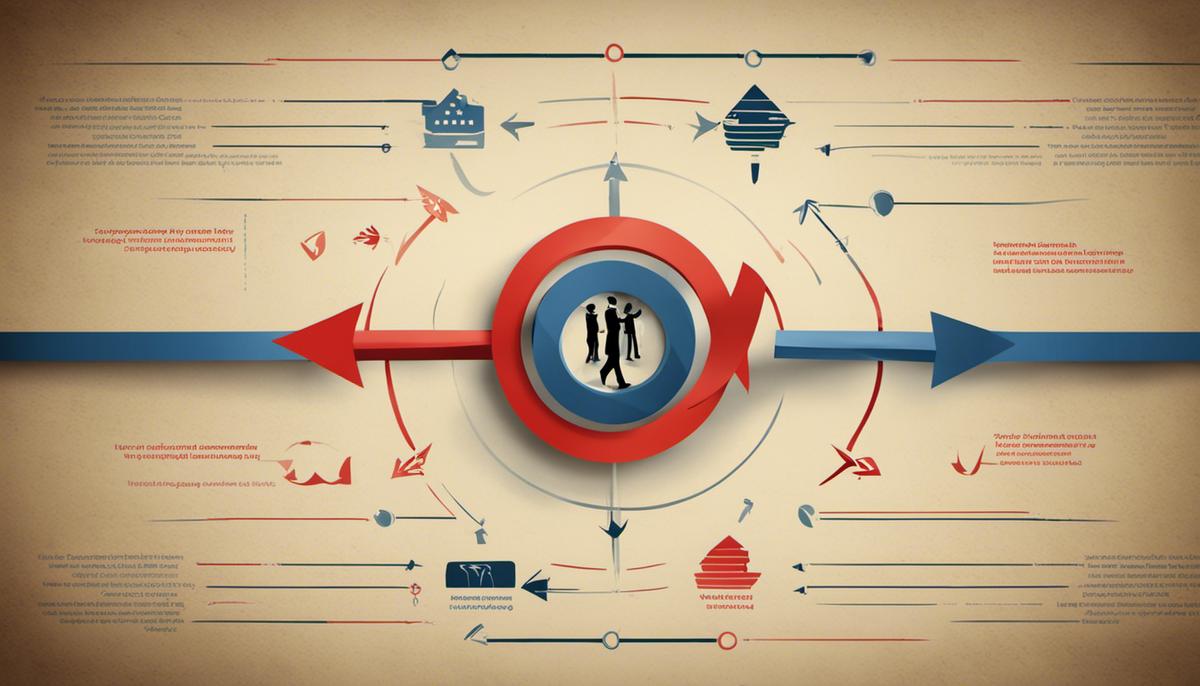Effective leadership is defined not by dictation and power, but through the art of building trust among teams. Authenticity, transparency, consistency, and reliability are the pillars that help a leader foster a climate of trust, setting the stage for superior teamwork and collaboration. In a world where team dynamics and business scenarios are ever-changing, the ability to establish, maintain and enhance trust becomes a linchpin for successful leadership. This piece provides a dive into the role trust plays in leadership, traits of trustworthy leaders, strategies for trust-building, trust-eroding mistakes to avoid, and suggestions for sustaining trust in the long haul.
Understanding the Role Trust Plays in Leadership
Understanding the Role Trust Plays in Leadership
Central to the concept of leadership is trust. It’s a vital component in any professional relationship and serves as the foundation on which successful leadership is built. Leaders who cultivate and demonstrate trust can take their teams to new heights in terms of performance and productivity. A trustworthy leader promotes open communication, reduces micromanagement, and fosters an environment where team members feel confident contributing ideas and taking risks.
Why Trust is Essential for Successful Leadership
Trust in leadership is a determinant of numerous positive outcomes in the workspace. Not only does it facilitate cooperation and collaboration, but it also improves morale and increases job satisfaction. Without trust, employees are less likely to follow directives or commit to a leader’s vision. When trust is established, it enables leaders to inspire and motivate their teams more effectively, ultimately enhancing organizational performance and success.
Impact of Trust on Team Dynamics and Performance
Trust has a significant influence on team dynamics and performance. A team built on trust tends to have better communication, stronger cooperation, and a greater commitment to common goals. Trusting relationships among team members can foster creativity and innovation as individuals feel more comfortable sharing their ideas and perspectives. A lack of trust, on the other hand, can lead to defensive behavior, decreased collaboration, and hindered performance.
The Relationship Between Trust and Leadership Effectiveness
There’s a strong correlation between trust and leadership effectiveness. Leaders who are trusted by their teams generally have a higher capacity for impact compared to those who aren’t. This effectiveness is seen in higher productivity rates, enhanced team engagement, and improved employee retention. Trusted leaders can more easily navigate challenges and instigate changes as their teams feel more secure in their leadership and decision-making abilities.
How Trust Affects Workplace Harmony
Workplace harmony is another aspect profoundly affected by trust. In a trust-based environment, employees are more likely to align their actions with the organization’s mission and vision, fostering greater harmony. Trust reduces tension and workplace conflicts because there is open communication, fairness, and respect in interactions. It reduces doubts and fears, promoting stability and workplace satisfaction.
Establishing Trust as a Leadership Attribute
In the world of leadership, trust isn’t an entitlement—it’s an achievement. Effectual leaders are fully aware of this fundamental principle and thus, employ various strategies to instil trust within their teams. This entails the demonstration of consistent behaviours, the delivery of clear and concise communications, exuding integrity, and providing suitable levels of transparency. Demonstrating empathy and making decisions that are both sensible and reliable also adds to their trustworthiness. More so, acknowledging errors, respecting confidentiality and steering clear from glorifying individual accomplishments over collective success are crucial components to establishing trust within a leadership role.

Traits of Trustworthy Leaders
The Role of Authenticity in trustworthy Leadership
Authenticity is a critical factor in building trust as a leader. Leaders who are authentic have a keen sense of self-awareness, they are honest and uphold integrity at all times. They neither portray counterfeit characters nor indulge in manipulating their team members. Instead, they are at ease with their true selves and advocate for the same transparency in their leadership approach. These leaders can identify and appreciate the unique skills, values, and viewpoints present within their teams, creating an environment where team members feel recognised and valued. This healthy exchange of respect and admiration paves the way for mutual trust, fostering a group dynamic that supports collaboration, productivity, and commitment.
Transparency: A Key Trait of Trustworthy Leaders
Another critical characteristic of trustworthy leaders is their transparency. Transparent leaders are honest and open in their interactions, promoting a culture where communication is encouraged. They practice openness in all their dealings, providing clear explanations for their decisions and actions. Team members are more inclined to trust their leader when they perceive them as transparent. This trust positively affects engagement, motivation, and job satisfaction, leading to a more harmonious and productive workspace.
Consistency Fosters Trust
Consistency is a pivotal trait in fostering trust. A consistent leader reliably upholds his/her standards and values. Consistency ensures predictability, supplying team members assurance of what to expect. It diminishes ambiguity and uncertainty, thus reducing anxiety and resistance. In a consistent environment, team members can entirely focus on their tasks without worry about unpredictable changes or inconsistencies. Consistent leaders earn respect, trust, and loyalty from their teams, which promotes a sense of stability and security within an organization.
Reliability in Trustworthy Leadership
Reliability is a non-negotiable trait for a trustworthy leader. A reliable leader sticks to commitments, honors deadlines, and delivers on promises. They can be depended upon to do what they say they will, providing a strong foundation required for trust to thrive. Being reliable not only sets an example for the team but also encourages reciprocal behaviour. When team members can rely on their leaders, faithfulness is fostered, creating a dynamic work environment where innovation, problem-solving, and effective collaboration can thrive.
The Impact of Trustworthy Leadership Traits
Developing and exhibiting traits such as authenticity, transparency, consistency, and reliability can profoundly enhance your leadership capacity by fostering trust. Leaders who incorporate these qualities cultivate a space of openness, honesty, and mutual respect. This nurturing environment encourages trust and commitment among team members, making them feel secure. Consequently, this encourages heightened productivity, improved communication, and increased job satisfaction. The effectiveness of these leadership skills in fostering trust ultimately reflects in organizational success and endurance.

Building Trust: Strategies and Techniques
The Importance of Demonstrating Competence as a Leader
Demonstrating your competence is a crucial approach in asserting your leadership and building trust within your team. This not only implies showcasing your knowledge and skills but also your consistent ability to deliver successful results. The skills to define clear objectives, develop effective strategies, and make beneficial decisions for your team and organization display your competence as a leader. When your team witnesses your capabilities in action, they develop faith in your leadership, subsequently trusting in your ability to guide them towards success. Additionally, staying updated with industry breakthroughs and trends fortifies your decision-making process and reinforces your team’s perception of you as an adept, competent leader.
Showcasing Integrity to Foster Trust
Another crucial factor in leadership trust-building is integrity. Integrity is personified through honesty, consistency, and moral ethics. As a leader, you should lead by example and uphold the highest standards of integrity. This involves keeping commitments, being honest even when it’s uncomfortable, admitting mistakes, and taking responsibility. When leaders exhibit integrity, it promotes an atmosphere of trust and respect, encouraging subordinates to emulate these actions.
Maintaining Honesty in Leadership
Honesty is a vital element in trust-building. A leader who communicates openly, honestly, and transparently is more likely to win the trust of their team. This requires providing clear, truthful feedback, acknowledging shortcomings, and avoiding any forms of deception. Additionally, sharing vital information regarding the organization and any changes that might affect team members can further strengthen the trust. Transparency in decision-making processes further promotes trust and nurtures an environment of mutual respect.
Valuing Openness in Leadership
Building trust also involves valuing openness. Cultivating an open leadership style where everyone’s opinion is welcomed fosters trust and inclusivity. Leaders who approach team members with an open attitude encourage open communication — the sharing of ideas, criticism, and concerns without fear of repercussions. Active listening also fosters openness and encourages team members to share their thoughts and ideas, knowing they are valued. This level of open engagement shows that you respect your team’s input and are ready to learn from them as well, strengthening trust across the board.
Creating a Safe Environment for Expression
To establish trust, a leader should create a safe and supportive environment where employees feel comfortable expressing their ideas and concerns. This sense of psychological safety allows employees to take risks, make mistakes, and learn without fear of judgment or punishment. Leaders can cultivate this atmosphere by promoting a culture of learning and innovation, emphasizing the importance of teamwork, and rectifying mistakes as learning opportunities rather than focusing on blame. When employees feel safe, their trust in their leaders naturally increases, leading to better collaboration and productivity.
Utilizing Emotional Intelligence
Emotional intelligence is a key element in trust-building. A leader who demonstrates empathy, understands team members’ feelings, and responds appropriately is more likely to build trust. Emotional intelligence allows you to build strong relationships with your team, promoting a more harmonious and efficient working environment. By recognizing and respecting the emotional needs of each team member, you strengthen their trust in your leadership.
Consistent Communication: A Cornerstone of Trust
Building trust is heavily reliant on consistent communication. The importance of regular check-ins and updates, both in one-on-one discussions and group settings, cannot be overstated. By ensuring your presence and displaying your dedication to their growth, your team starts to trust you more. Regular communication paves the way for understanding the unique needs of each team member, swiftly addressing any arising issues, and keeping everyone informed about changes within the organization. This approach demonstrates that you value your team members, thus strengthening their trust in your leadership.

Trust-Building Mistakes Leaders Must Avoid
The Implications of Poor Communication on Trust
The principle of consistent and clear communication is at the core of trust-building. However, some leaders fall short in keeping open and steady communication with their team members. This negligence often perpetuates misunderstandings and misinformation, inevitably leading to a serious erosion of trust. It leaves employees feeling neglected, insignificant, or duped. To evade this pitfall, leaders should vigorously pursue transparency in their communication. Offering regular briefs about the company’s goals, alterations, protocols, and individual projections works wonders in fortifying trust within a team.
The Threat of Inconsistent Actions
Another common pitfall undermining trust in leadership is inconsistency. Leaders who say one thing and do another, or change their decision-making styles without explanation, can quickly lose their credibility. Employees depend on their leaders to establish a stable environment. When leaders consistently uphold the values, expectations, and standards set forth, it fosters a sense of predictability and security, which is critical in building trust.
The Damage of Betraying Trust
Perhaps the most devastating mistake is the betrayal of trust, which often occurs due to dishonesty or unethical behavior. Leaders must prioritize integrity, truthfulness, and fairness if they wish to instill trust and respect from their team. Once trust has been betrayed, it takes significant effort to recover and rebuild it.
The Problem of Unfulfilled Promises
Leaders often promise things to their teams—like promotions, raises, or improvements in workspace conditions—expecting to keep those promises. However, when circumstances change and those promises are not fulfilled, trust can erode quickly. Leaders should avoid making commitments they aren’t entirely certain they can keep and instead, be realistic and transparent about potential changes or challenges.
Recovering and Rebuilding Trust
While the mentioned mistakes can damage trust, it isn’t irreparable. Leaders can take steps to mend broken trust. Accepting responsibility for mistakes, apologizing sincerely, listening to employees’ concerns and taking action to address them are key to rebuilding trust. Further, things like open and consistent communication, consistency, and honesty gain importance after a breach, and it often takes a commitment to demonstrating these behaviors over the long term before trust is restored.
Building trust as a leader isn’t just a one-off process; it requires continuous effort and vigilance to prevent potential missteps. Trust, although fragile and easily broken, holds immense power. Its presence within a team can be associated with increased productivity, satisfaction, and overall success. Thus, steering clear of common fallacies and dedicating oneself to trust-building practices is indispensable for any effective leader.

Maintaining and Strengthening Trust Over Time
Sustaining Trust: An Ongoing Commitment
Creating and preserving trust within a team or organization is more than a singular act. Leaders need to persistently prove their reliability over time to ensure stable levels of trust and solid foundations. Practices such as ensuring fair treatment, maintaining transparency, and revealing pertinent information all contribute to building trust. Furthermore, acknowledging the efforts of the team, rewarding good performances, and showing empathy can also strengthen trust.
Adapting to Changing Dynamics
Business environments and team dynamics are always changing. A leader must be flexible and adaptable to ensure they’re addressing changes in a way that fosters trust. If team composition changes, leaders need to invest time in building new relationships and reinforcing existing ones. In case of policy changes or corporate restructuring, leaders should communicate these changes transparently and honestly, addressing any concerns promptly.
Act with Integrity
A leader’s demonstrated integrity is key to maintaining trust. This means not only saying you will do something, but following through on that promise. It’s about being consistent in actions, values, methods, measures, principles, expectations, and outcomes. A leader’s actions carry more weight than their words in the eyes of their team members. Team members trust a leader more when they consistently behave in ways that are honest, ethical, and considerate of the team’s interests.
Regular Communication
Regular and meaningful communication between leaders and team members is crucial. Lack of communication can lead to uncertainty, a prime destroyer of trust. Frequent check-ins, open-door policies, and active listening can go a long way in demonstrating trustworthiness and commitment to the team.
Building Trust after Setbacks
Inevitable setbacks or failures can undermine trust. Leaders can circumvent this through transparent communication about what went wrong and showing a clear strategy to avoid a recurrence. Taking responsibility and demonstrating resilience will further reinforce the leader’s trustworthiness.
Feedback, Recognition, and Flexibility
Receiving and offering feedback is another essential trust-building strategy. It shows that a leader is open to criticism and willing to improve, while also indicating that they care about the team’s development. Similarly, recognizing team members’ success builds a positive atmosphere and reinforces trust. Lastly, flexibility in leadership styles according to the situation or individual is another character trait of trustworthy leaders.
Future-proofing Trust Building Strategies
Maintaining trust isn’t a static process. Leaders must continually learn, adapt and integrate new trust-building strategies, especially in changing business conditions or unexpected circumstances, to keep up with the evolving needs and expectations of their team members. This could mean adopting new communication tools, revising old policies, or even redefining team structures and roles. Leaders who are proactive and forward-thinking in their approach to building trust are likely to nurture and sustain high trust levels over the long run.

The journey of building and maintaining trust as a leader is continuous, demanding consistent demonstration of authenticity, reliability, and competence. It requires avoiding trust-eroding mistakes and adjusting strategies according to evolving team dynamics. Remember, trust is an emotion, as much as it is an intellectual process. At all times, leaders must keep the lines of communication open, creating a safe environment for their teams to express their views and concerns. The heritage of trust is powerful, encouraging a positive workplace culture, improved team performance, and, ultimately, effective leadership.
